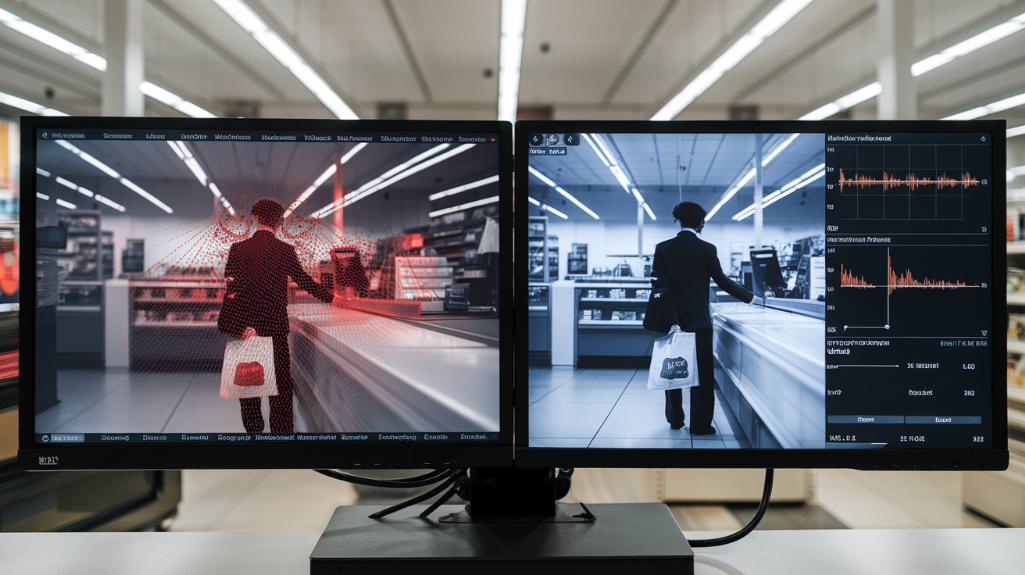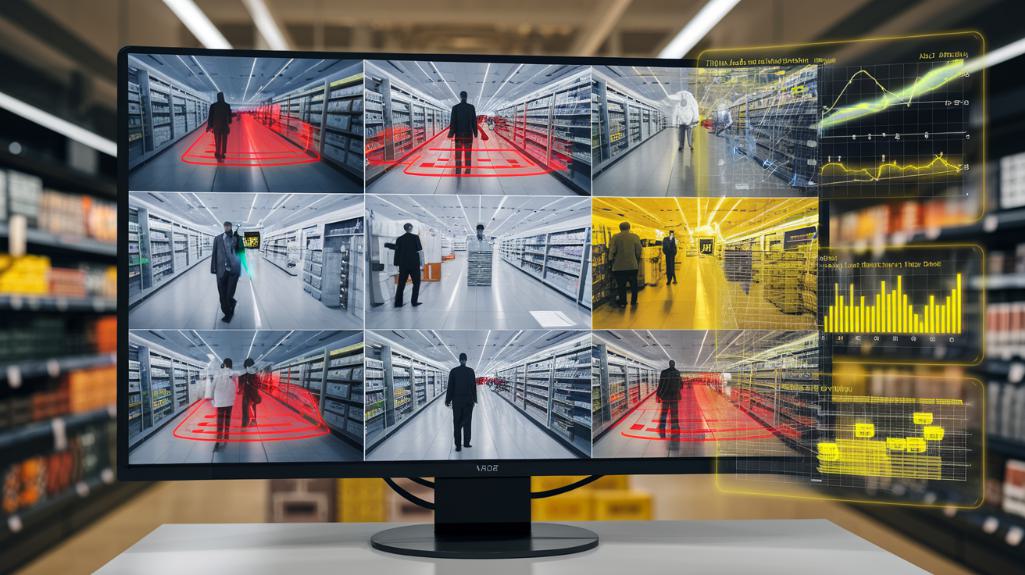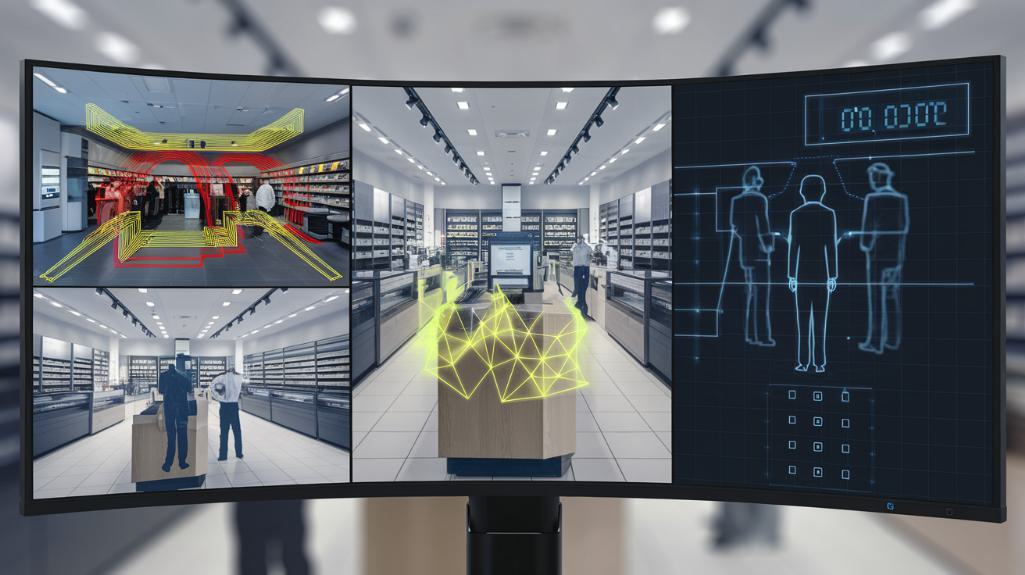AI systems detect retail employee theft through sophisticated pattern analysis of transactions, monitoring anomalies in refunds, discounts, and voids against established baselines. Advanced video analytics track suspicious employee behaviors and movements while machine learning algorithms identify potential "sweethearting" incidents at point-of-sale terminals. Real-time monitoring enables immediate response to theft indicators, with data showing a 30% reduction in shrinkage after implementation. Understanding these AI detection methods reveals vital insights for modern retail security.
Key Takeaways
- AI analyzes transaction patterns to detect unusual refunds, discounts, and voids that deviate from normal employee baselines.
- Machine learning algorithms monitor point-of-sale systems for "sweethearting" behavior between employees and customers.
- Video analytics track employee movements and interactions, identifying suspicious behavior patterns through facial recognition and motion analysis.
- AI systems compare transaction timing and frequency against historical data to identify coordinated theft schemes.
- Real-time monitoring alerts managers to suspicious activities immediately, enabling quick response to potential theft incidents.
The Rising Challenge of Employee Theft in Modern Retail

While retailers have long grappled with inventory shrinkage, the modern retail environment faces an unprecedented surge in employee theft, with U.S. businesses losing $61.7 billion annually to various forms of internal fraud.
The complexity of employee theft has evolved beyond simple cash register theft to include sophisticated schemes like sweethearting, necessitating advanced detection methods. AI-powered monitoring systems now analyze point-of-sale transactions and employee behavior patterns to identify suspicious activities in real-time.
These systems, coupled with facial recognition technology, enable retailers to prevent potential theft before significant losses occur. Additionally, the use of AI-powered solutions enhances security measures within retail environments, allowing for better monitoring and prevention of theft incidents.
As theft incidents involving violence increase by 120%, retailers are implementing thorough security measures that enhance operational efficiency while protecting assets.
This systematic approach to combating internal fraud represents a critical advancement in retail loss prevention strategies.
How AI Systems Detect Suspicious Transaction Patterns
AI systems employ sophisticated algorithms to analyze transaction patterns and identify potential employee theft through automated monitoring of point-of-sale data.
The technology scrutinizes patterns of refunds, discounts, and voids that deviate from established baselines, flagging suspicious sequences that may indicate fraudulent schemes.
These systems evaluate transaction timing, frequency, and customer relationships to detect coordinated theft activities where employees may be working with external parties or manipulating refund processes for personal gain.
Transaction Pattern Red Flags
Modern transaction monitoring systems deploy sophisticated algorithms to identify suspicious patterns that may indicate employee theft. AI systems analyze transaction data to detect anomalies like excessive discounts, unusual refund frequencies, and repetitive transaction sequences that deviate from established norms.
Detection algorithms specifically target "sweethearting" behavior by monitoring point-of-sale systems for unauthorized price reductions or complimentary items given to associates.
The AI continuously learns from historical internal theft cases, enabling it to recognize evolving fraudulent activities with greater accuracy. Key suspicious behavior indicators include frequent transaction voids, override authorizations, and coordinated purchase patterns suggesting employee-customer collusion.
These transaction patterns, when flagged by AI systems, allow retailers to investigate potential theft before substantial losses accumulate.
Detecting Refund Fraud Schemes
Building upon transaction monitoring capabilities, sophisticated refund fraud detection represents a critical component of AI-driven loss prevention systems. AI algorithms analyze transaction patterns at point-of-sale terminals, identifying anomalies that indicate potential refund fraud schemes.
These systems track employee behavior by comparing individual refund activities against established baseline metrics, flagging suspicious activities such as excessive refunds or repeated transactions to the same customer.
Machine learning models detect unauthorized discounts and receipt manipulation through pattern recognition, enabling proactive intervention in retail operations.
Real-time monitoring allows management to address potential fraud immediately, greatly reducing response time to suspicious transactions.
Retailers implementing AI-based loss prevention strategies have documented measurable reductions in refund fraud incidents, demonstrating the technology's effectiveness in protecting profit margins and maintaining operational integrity.
Advanced Video Analytics for Employee Behavior Monitoring
Sophisticated video analytics powered by artificial intelligence have revolutionized how businesses monitor employee behavior for potential theft. AI algorithms analyze real-time footage to detect suspicious actions and patterns that may indicate internal theft. These systems integrate with existing surveillance systems to provide thorough monitoring while utilizing facial recognition to identify known offenders.
| Capability | Security Benefit |
|---|---|
| Pattern Analysis | Detects unusual movements and interactions |
| Transaction Monitoring | Flags suspicious POS activities |
| Facial Recognition | Identifies known offenders in restricted areas |
| Continuous Learning | Reduces false positives over time |
The technology's continuous learning capabilities enhance detection accuracy through adaptive algorithms, enabling retailers to proactively address potential theft before significant losses occur. This automated approach provides more reliable and consistent monitoring compared to traditional surveillance methods.
Real-Time Alert Mechanisms and Security Response
Rapid response capabilities enabled by AI-driven alert mechanisms form the cornerstone of effective employee theft prevention systems. These systems leverage real-time monitoring and anomaly detection to identify suspicious activities that deviate from established operational patterns.
When AI detects potential employee theft through point-of-sale irregularities or unusual transaction patterns, alert mechanisms instantly notify security teams for immediate intervention.
The system's proactive approach combines video surveillance analysis with transaction monitoring, allowing for thorough detection of activities like unauthorized refunds or sweethearting. This integration enables security personnel to respond swiftly, minimizing potential losses.
Data-Driven Prevention Strategies and Risk Assessment

Through extensive data analysis and machine learning algorithms, organizations can develop targeted prevention strategies that identify potential theft risks before they materialize into losses.
Predictive analytics leverage historical transaction data to create risk profiles, enabling retailers to proactively address high-risk scenarios and behaviors.
Advanced data analysis transforms transaction histories into actionable intelligence, helping retailers stop theft before it occurs.
AI-driven anomaly detection systems continuously monitor inventory management processes, comparing expected stock levels against actual counts to identify discrepancies.
These data-driven strategies enable loss prevention teams to focus resources on areas of greatest vulnerability.
The continuous learning capabilities of AI systems enhance risk assessment accuracy over time, reducing false positives while improving detection rates of genuine employee theft incidents.
This systematic approach to retail store monitoring allows organizations to implement preventive measures based on empirical evidence rather than assumptions, leading to more effective loss prevention outcomes.
Measuring AI's Impact on Retail Loss Prevention
Quantifying the effectiveness of AI-powered loss prevention systems reveals significant reductions in retail shrinkage and employee theft incidents. Implementation data shows a 30% decrease in shrinkage within the first year of deployment, demonstrating AI's vital role in retail loss prevention.
The integration of predictive analytics enhances theft detection accuracy by identifying behavioral anomalies in point-of-sale transactions and inventory management. AI surveillance systems monitor customer interactions, effectively targeting sweethearting practices where employees provide unauthorized discounts.
These technological solutions reduce false positives in internal theft investigations, allowing loss prevention teams to focus resources on verified incidents. Through continuous analysis of transaction patterns and employee behaviors, AI provides retailers with data-driven insights that strengthen their shrinkage reduction strategies and optimize prevention protocols. Additionally, the use of real-time monitoring ensures that unusual patterns are detected promptly, further enhancing theft prevention efforts.
Frequently Asked Questions
Does AI Monitoring Affect Employee Morale and Workplace Trust?
AI monitoring potentially diminishes employee engagement through increased surveillance stress and privacy concerns, creating trust issues and damaging workplace atmosphere. Performance anxiety and communication barriers emerge when transparency and feedback mechanisms are insufficient.
What Happens to Falsely Flagged Employees During Investigations?
Investigation procedures require HR involvement and workplace transparency while protecting employee rights. False accusations warrant careful case resolution to prevent legal implications and mitigate reputational damage through structured communication strategies and disciplinary review.
Can Employees Request Access to Their Ai-Monitored Data?
Employee data access rights vary by jurisdiction and company policies. Privacy regulations often mandate data transparency, while monitoring consent agreements determine specific access procedures for AI-collected surveillance information.
How Long Does the System Store Facial Recognition Data?
Facial data retention periods vary based on legal regulations and company policies, typically ranging from 30-180 days. Systems implement encrypted storage, strict access limitations, and automated deletion procedures to maintain compliance standards.
What Backup Systems Exist if AI Surveillance Technology Fails?
Standard backup procedures include manual oversight, alternative surveillance methods, human verification processes, and documented incident response protocols. Regular system audits guarantee data redundancy while addressing potential technology limitations through established contingency plans.
Conclusion
AI-powered retail loss prevention systems have demonstrated significant ROI through multi-layered detection capabilities, reducing employee theft by up to 27% in pilot implementations. The integration of predictive analytics, behavioral monitoring, and automated alerts enables retailers to proactively identify high-risk scenarios before losses occur. As these systems evolve, their ability to distinguish legitimate actions from fraudulent behavior continues to improve accuracy rates and operational efficiency.



